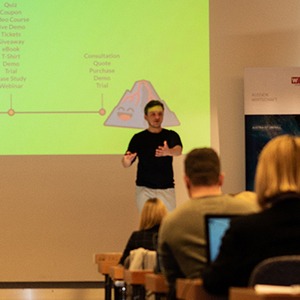To understand the lifetime value to customer acquisition cost ratio (LTV:CAC), it’s important first to understand the two terms independently.
Defining the Terms
- Lifetime Value: Lifetime value (LTV) is a prediction of the total revenue that a customer will generate during their relationship with a company.
- Customer Acquisition Cost: Customer acquisition cost (CAC) is the total amount of money a company spends to acquire a new customer.
Now, we combine the two concepts. The LTV:CAC ratio is a metric that predicts a company’s ROI from acquisition expenses, such as paid ads, SEO, content creation, and marketing salaries.
How To Calculate the LTV:CAC Ratio
In order to calculate your LTV:CAC ratio, simply follow the following formula:
LTV:CAC = (Lifetime Value) ÷ (Customer Aquisition Cost)
You’ll need to calculate both LTV and CAC before you can find the ratio. Luckily, these are two metrics that most businesses will have on hand. And if not, they’re fairly easy to calculate!
To give an example of the calculation, let’s say that the average lifetime value of a customer to your company is $1,000, and it costs your company $200 to acquire a new customer.
This would give you a 5.0 LTV:CAC ratio. But what does that actually mean?
What Is a Good LTV:CAC Ratio?
Different industries and business models will vary when it comes to a good LTV:CAC ratio. But we can still give you some fairly reliable benchmarks:
- Low: 1.0 – 2.9
- Good: 3.0 – 5.9
- High: 6.0 – 9.9
- Very High: 10.0+
Any LTV:CAC ratio above 0 is technically profitable on paper, but almost all businesses have expenses outside of customer acquisition. For example, you have to pay for rent, office supplies, software, employee salaries, and other general overhead costs.
This is why it’s important to have a healthy LTV:CAC ratio. A ratio that’s too low means that your company isn’t making enough money off of each customer to cover basic expenses. A ratio that’s too high means that your company is likely underspending on acquisition and limiting your growth.
How To Improve LTV:CAC Ratio
There are a few key ways to improve your LTV:CAC ratio:
- Focus on customer retention and loyalty programs. The longer a customer stays with your company, the more money they’ll spend. So anything you can do to keep customers around will have a positive impact on LTV.
- Work on making acquisition more efficient. This could involve making changes to your marketing strategy, such as trying new channels or targeting a different audience. Segment analysis can be especially helpful here!
- Try to increase your prices. If you’re selling products or services for too low of a price, you’re leaving money on the table. Of course, this isn’t always possible or practical. But if you can find a way to do it, it will have a big impact on your LTV:CAC ratio.
Use Analytics to Strike a Balance
Improving your LTV:CAC ratio is important for the long-term health of your business. By focusing on customer retention, improving your marketing strategy, and increasing prices, you can make sure that your company is profitable and sustainable in the long run.
At Growth Mentor, we can connect you with 400+ CEOs, founders, and marketing experts who can help you grow your business. Schedule a call with one of our growth mentors today and see how we can help you take your business to the next level!



